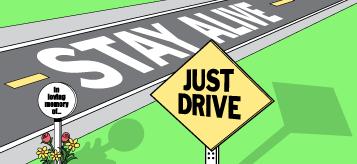
Fewer drunk drivers cause fewer accidents and claim fewer lives in Southwest Florida drunk driving crashes because of the minimum drinking age of 21, according to the Lee County and national chapters of Mother’s Against Drunk Driving.
Florida injury lawyers and personal injury attorneys in Fort Myers, Naples, Cape Coral and throughout Southwest Florida handle dozen’s of cases in which an innocent motorist is seriously injured or killed by the senseless, careless and negligent acts of drunk drivers.
Mother’s Against Drunk Driving came out swinging this week after a newsmagazine report on CBS’ “60 Minutes” took up the issue of whether the 21-and-up legal drinking age nationwide actually contributes to instances of underage binge drinking among teens.
The 21-and-up law “saves about 900 lives a year,” said Brenda Gellinger, local MADD president and family support coordinator for the Lee County Sheriff’s Office. She said the “60 Minutes” program “missed the mark by not including the fact that changing the drinking age would only pass the buck to high school principals.”
The head of MADD nationally was even more outspoken.

“We are deeply disturbed by the so-called debate over the drinking age that has minimized the lifesaving benefits of the 21 law,” said Laura Dean-Mooney, MADD’s national president. “The 21 law saves lives — 900 a year on the roadways, including those 21 and older impacted by underage driving and driving.”
MADD said the current drinking age is supported by the American Medical Association, the National Transportation Safety Board, the International Association of Chiefs of Police and the Insurance Institute of Highway Safety.
Last fall, the presidents of 100 universities — including Dartmouth, Virginia Tech and Duke, said the two-decades since the drinking age was raised from 18 to 21 in the mid-1980s have been unsuccessful in discouraging underage drinking. And some are arguing, like prohibition, the restrictions on young adults are forcing it underground, away form parents and adults who could teach moderation, and actually making the problem worse.
MADD counters that binge drinking and alcohol abuse have always been problems on college campuses — and that alcohol abuse and dependence rates are actually higher for college students than non-college students, regardless of the drinking age.
Donna Shalala, president of the University of Miami and former U.S. Department of Health and Human Services Secretary, supports maintaining the drinking age at 21.
“As a three-time university president, I can tell you that losing a student to an alcohol-related tragedy is one of the hardest and heart-rending experiences imaginable,” Shalala said. “It’s not just the loss of life but the loss of the future and that potential that bright, young individual had to offer.”
In the two decades since states began setting the legal drinking age at 21, the government estimates that 26,000 lives have been saved. Of the 5,000 total alcohol-related deaths among 18 to 24 year olds, 80 percent, or 4,000, were the result of traffic crashes.
Continue reading ›
 As millions of Americans prepare to enjoy a fun family holiday celebrating our nation’s birth, Florida injury lawyers are urging those using fireworks to always put safety before sparklers.
As millions of Americans prepare to enjoy a fun family holiday celebrating our nation’s birth, Florida injury lawyers are urging those using fireworks to always put safety before sparklers. Florida Injury Lawyer Blog
Florida Injury Lawyer Blog













 Young drivers — already four times more likely to get into an accident — were twice as likely to use a cell phone while driving, according to the AAA study and a survey by FindLaw.
Young drivers — already four times more likely to get into an accident — were twice as likely to use a cell phone while driving, according to the AAA study and a survey by FindLaw.



